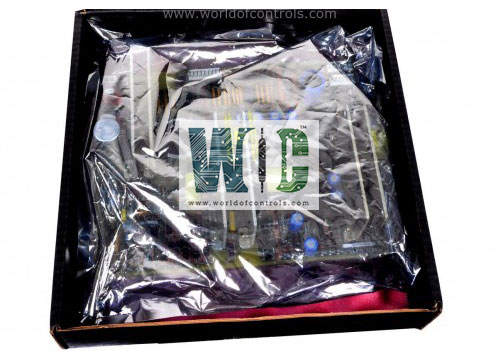SPECIFICATIONS
Part Number: IS230SNIAH4A
Manufacturer: General Electric
Series: Mark VIe
Function: Isolated Analog Module
Availability: In Stock
Country of Manufacture: United States (USA)
Functional Description
IS230SNIAH4A is an isolated analog module developed by General Electric. It is a part of GE Mark VIe system. It functions as an interface that converts analog signals into digital signals that can be processed by the PLC.The precision of the conversion is typically measured in bits. High accuracy ensures reliable measurements, which is critical for maintaining system performance.
Processor
- The processor board in the Mark VIe Ethernet I/O pack is equipped with a high-speed processor and both RAM and flash memory. The processor ensures efficient execution of tasks, enabling real-time control and data handling for complex operations. RAM provides temporary storage for ongoing processes, while the flash memory holds critical system information, including firmware and configuration data, ensuring system reliability even after power cycles.
- Two fully independent Ethernet ports provide 10/100 Mbps communication capabilities, allowing for redundancy and flexible connectivity. These ports can operate simultaneously on different networks, which enhances system reliability and scalability by ensuring continuous communication, even in the event of network issues. The connectors ensure secure and stable connections, ideal for industrial environments.
- The hardware watchdog timer and reset circuit are crucial for maintaining system stability. The watchdog continuously monitors the processor’s activity, and if it detects any malfunction, it initiates a system reset. This feature ensures the system can recover from faults automatically, minimizing downtime and preventing total system failure.
- To ensure the system operates within safe temperature limits, a local ambient temperature sensor is included. This sensor monitors the temperature around the board, and if it detects excessive heat, it can trigger alarms or cooling actions to prevent overheating, thus extending the life of the hardware.
- The processor board also features an infrared (IR) serial port, which allows for local, wireless communication with diagnostic tools or handheld devices. This port enables operators to easily access diagnostic information or modify system settings without needing a physical connection to the board, improving convenience during maintenance or troubleshooting.
- Status-indicating LEDs provide real-time visual feedback about the board’s operational status. These LEDs indicate conditions such as power status, communication activity, and fault detection, allowing technicians to quickly diagnose issues by simply observing the board’s lights.
- The board includes an electronic ID system, which stores important information such as serial numbers and manufacturing details. It can also read the IDs of other boards connected to the system, ensuring that all components are correctly identified and properly integrated. This feature supports seamless system configuration and compatibility checks.
- Programmable logic is another significant feature of the processor board, working closely with the acquisition board to manage real-time data processing and signal acquisition. This logic allows for customization in processing tasks, making the board adaptable to various industrial applications.
- An input power connector with a soft start and current limiter ensures that power is applied gradually to prevent surges, while the current limiter protects the board from overloads. This design safeguards the board from potential damage during power fluctuations, enhancing its longevity.
Hardware Overview
- Designed to accept input voltage signals from up to 10 channels via a terminal board. These input signals come from external sensors, such as temperature or pressure transducers, providing crucial real-time data. The terminal board acts as the connection interface, ensuring secure transmission of these analog signals to the system. The PAIC is capable of handling multiple input signals, allowing simultaneous monitoring of various parameters in a control environment.
- At the heart of the system is the analog multiplexer (MUX) block, which enables the PAIC to efficiently switch between different input channels. The multiplexer selects one input signal at a time and routes it to the next stage of processing, ensuring that each signal is handled without interference. This rapid switching between channels allows for efficient time-sharing of signals, enabling real-time data collection from multiple sources with minimal delay.
- Includes several gain and scaling options, which adjust the strength and range of the input signals. The gain amplifies weaker signals, ensuring they are measurable, while the scaling function adjusts each signal to fit within the input range of the analog-to-digital converter (ADC). These adjustments are essential for maintaining signal accuracy and preventing distortion or clipping, especially when working with sensors that produce varying signal strengths.
- Once the signals are properly adjusted, they are converted into digital data using a 16-bit analog-to-digital converter (ADC). This high-resolution converter provides precise digital representation of the analog signals by translating them into 65,536 discrete levels. The high level of detail offered by the 16-bit resolution is crucial for applications that require fine granularity, such as temperature control or pressure monitoring, ensuring accurate and reliable system performance.
WOC has the largest stock of Speedtronic control spares. Please contact our staff by phone or email for pricing and availability on any parts and repairs
FREQUENTLY ASKED QUESTIONS
What is IS230SNIAH4A?
It is an isolated analog module developed by General Electrics.
What is the function of the analog multiplexer (MUX)?
The analog multiplexer (MUX) is responsible for switching between the different input channels. It selects one signal at a time and sends it to the next stage for processing, allowing the system to share time efficiently among all channels without interference.
How do gain and scaling work in the analog input hardware?
Gain amplifies weaker signals, ensuring they are strong enough to be accurately measured. Scaling adjusts the signal so it fits within the input range of the analog-to-digital converter (ADC), preventing clipping or distortion.
